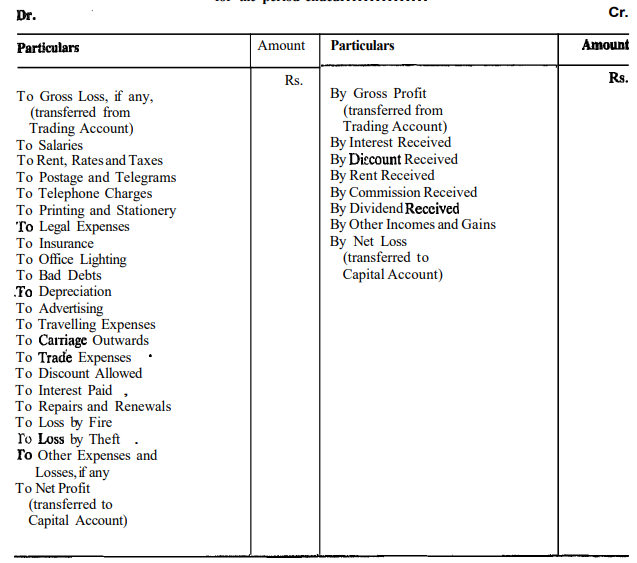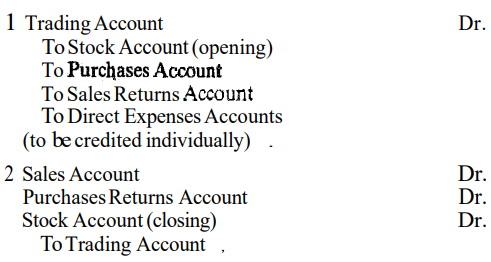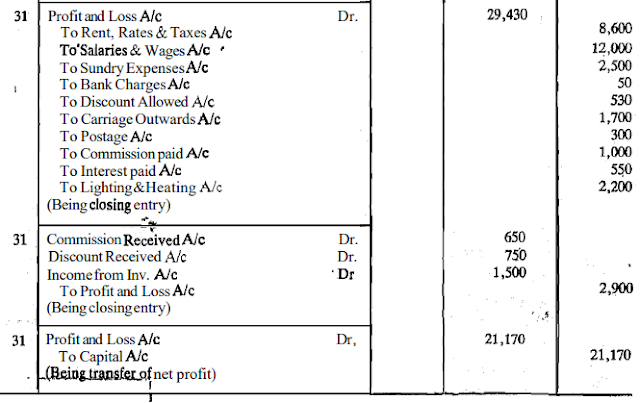7.3 Trding and Profit and Account
You know the Profit and Loss Account is prepared for ascertaining the profit or loss of
the business. This is worked out in two stages. In the first stage we work out the gross profit or gross loss and in the second stage, the net profit or net loss. Hence, the profit
I and LOSS Account is divided into two sections, The first section is called Trading Account, It reveals the gross profit or gross loss. The second section is called Profit
and Loss Account which shows the net profit or net loss.
7.3.1 Trading Account
As stated above, the Trading Account is prepared for ascertaining the gross profit or
gross loss. The gross profit is defined as the excess of sales revenue over cost of goods
sold, This can be presented in the form of an equation as follows.
Gross Profit = Net Sales - Cost af Goods sold
Where i) Net Sales =Total sales -Sales Returns
ii) Cost of Goods Sold = Opening stock + Net Purchases
+ Direct Expenses - Closing stock
You know the terms 'Opening Stock' and 'Closing Stock' refer to the value of unsold
goods as at the beginning of the year and at the end of the year respectively. Such
stock may also include the semi-finished goods and raw materials. In order to arrive at
the cost of goods sold the opening stock is added to the net purchases while the
closing stock is deducted. The term 'Direct Expenses' refer to those expenses which
are incurred on the goods purchased till they are brought to the place of business for
sale. These include expenses such as freight, insurance, import duty, dock dues,
clearing charges, octroi duty, carriage, cartage, etc. The administrative expenses,
selling and distribution expenses, interest paid, etc. are termed as indirect expenses
and, therefore, are excluded from the cost of goods sold.
Look at Illustrations 3 and 4 and study how Cost of Goods Sold and the Gross Profit are-computed.
Illustrations 3
The following figures have been extracted from the books of a firm. Calculate the Cost of Goods Sold.
Illustration 4
On January 1,1987 afirm had stock of goods valued at Rs. 20,000. During the year the following transactions took place.
Form of Trading Account: The Equation for Gross Profit is also known as Trading
Account Equation. This equation foms the basis of preparing the Trading Account.
The Trading Account, like any other account in the ledger, has two sides-debit and
credit. The opening stock, purchases (less returns) and all direct expenses are shown
on the debit side of the Trading Account while sales (less returns) and the closing
stock on the credit side. The gross profit appears as the last item on the debit side
which, in fact is the excess of the total of credit side over the total of debit side. If
however, the total of the debit side exceeds the total of the credit side, it will be
treated as gross loss. This is shown as the last item on the debit side of the Trading
Account. The gross profitlgross loss thus worked out is transferred to the Profit and
Loss Account. Look at the Figure 7.1 for the form of Trading Account.
Based on the data'given in Illustration 4, The Trading Account will be prepared as
follows.
Trading Account of ..........
for the yaw ending Deccmber 31, 1987
Some Important Points
1 Purchases: This item refers to the goods purchased for resale and includes both cash,
and credit purchases. The purchases of assets which are meant for permanent use in '
business such as machinery furniture, etc., are not included in the purchases,
The amount taken to Trading Account will be the net amount of purchases (after
deducting purchase returnslreturns outwards.) If the proprietor has taken away some
goods from the business for his personal use, the same should also be deducted
from the total purchases.
2 Sales: It includes both cash and credit sales of goods and refers to the net amount of
sales (after deducting sales returns-returns inwards). Sales of old furniture, car,
machinery, etc. are not included in the sales. Similarly, sales of old newspapers etc.
are also excluded from sales. Such items are shown as miscellaneous income in the
Profit and Loss Account.
3 Wages: Wages are usually treated as a direct expense and so shown in the Trading
Account. The difficulty arises when wages are clubbed with salaries (an indirect
expense) and the Trial Balance includes a single amount for 'Wages and Salaries'.
In such a situation, the amount may be shown in the Trading Account. It is based on
the assumption that the item includes the salaries of the supervisory staff in the
factory itself. But, if the item in the Trial Balance reads 'Salaries and Wages' it will
be taken to the f rofit and Loss Account on the assumption that the item includes
wages of the office staff only. It should be noted that wages paid in connection with
the purchases of fixed assets or the construction of building should not be charged
to Trading Account. They are to be included in the cost of the concerned fixed
asset. There is another important aspect in relation to wages which rnust be
claiified. If a Manufacturii~g Account is prepared the wages paid to the factory
labour is debited to Manufacturing Account about which you will'learn later in this
unit.
4 Freight, Carriage and Cartage: When paid in connection with purchases of goods,
they are shown in the Trading Account. Such freight and carriage are also termed as
'Freight Inwards' and 'Carriage Inwards' respectively. 'Freight Outwards' and
'Carriage Outwards' relate to sales and therefore taken to the debit of Profit and
Loss Account,
5 Royalties: Royalties refer to the payments made for the use of copyright or a
patent. The amount of royalty is generally based on the quantity produced. It is,
therefore, treated as atlirect expense and charged to Trading Account. But if it is
calculated on the basis of quantity sold as in case of books, it is shown in the Profit
and Loss Account. Royalties are also paid to the Government for extraction of
minerals such as coal, diamond, gold, etc. These are charged to the Profit and Loss
Accoullt of the mining companies, You will learn about the accounting of such
royalties later under a separate course.
7.3.2 Profit and Loss Account
After ascertaining the gross profit by preparing the Trading Account, the businessman
proceeds to prepare the Profit and Loss Account in order to work out the net
profitlnet loss. You know the net profit is the excess of gross profit and other incomes
over the indirect expenses and losses. So, while preparing the Profit and Loss Account
we show gross profit and other incomes such as rent received, discount received,
commission received, interest and dividends etc. on the credit side, and all indirect
expenses and losses on the debit side. Indirect expenses include all administrative,
selling and distribution expenses such as salaries, rent and taxes,-postage and
stationery, insurance, depreciation, interest paid, office lighting, advertising, packing
carriage outwards, etc., while losses refer to items like loss by fire, loss by theft etc.
The difference between the two sides of the Profit ahd Loss Account represerit either
the net profit or net loss. If the total of the credit side is higher than the total of the
debit side, the difference is called net profit and if the debit side total exceeds the
credit side total, the difference is called net loss. The net profitlnet loss belongs to the
pfopkietbr and it is thyefore transferred to his Capital Account. Look at figure 7.2. It
shows various expenses. losses, incomes, etc. which usually appear in the Profit and
bss Account.
figure 7.2
Profit and Lo& Account ...............
for the period ended ...............
 Notes:
Notes:1 The heading for the Profit and Loss Account, as in the case of the Trading Account, indicates the name of
the business or proprietor and the period for which it is being prepared.
2 In addition to the items shown in the above form, there are certain items such as depreciation, bad debts,
provision for doubtful debts, interest on capital, interest on drawings, etc., which appear in the Protit and
Loss Account as a result of the adjustment entries. We shall discuss them in Unit 8.
Some Important Points
1 Rent, Rates and Taxes: These are charges levied by the municipal bodies on the
house property. It is a common item of indirect expenses debited to the Profit and 1 Loss Account.
2 Insurance: Generally, assets are insured to cover the risk of loss, say, by fire.
Premium paid to the insurance company should be treated as a business expense.
When assets such as factory building, factory machinery, etc. are insured, the
insurance premium should be debited to Trading Account. If on thp other hand, the
premium is paid for insurance of assets in the office building, office furniture, etc., it
should be charged to Profit and Loss Account.
3 Bad Debts: Bad debts denote the amount which could-not be recovered from the
debtors to whom the goods were sold on credit. It is aaloss and so debited to the
Profit and Loss Account. You will learn mw about their treatment in Unit 8.
4 hpmiation: Depreciation means decrease in the, value di. fued asset due to
normal wear and tear. You. know that every fixed asset such as machinery,
furniture, vehicle, etc. depreciates in value onaccount of its constant use. Such reduction in their value is a loss to the business and so charged to the Profit and Loss
Account. If, however, a Manufacturing Account is ako prepared, depreciation on
machinery and factory building is charged to the Manufacturing Amunt, while
depreciation on office building, office furniture, office equipment, etc. is
the Profit and Loss Account.
5 Trade Expenses: This item represents various small expenses incurred in the
business. They are also called General Expenses, Sundry or
miscellaneous Expenses.
6 Packing: The cost of packing materids such as p~lytheae bag, wrapping matexiah,
etc. for delivery is a distributiorl expense and hence charged to Profit and Lass
Account. Where packing is essential to make the products fit for sale, b the market
as in the case of cigarettes, biscuits, medicines, oil, etc. it is allled 'packaging9 and
such expenditure is charged to the Trading Account.
7 Smmpla: Generally, samples of goods are distributed free sf charge to kmease
sales. The cost of such samples should be treated as a selling expense and so debited
to Profit and Loss Account.
8 Income Tax: It is the tax payable by a person mn his income. In the case of a ssie
trading concern, the tax paid by the proprietor on the profits of the business is
treated as a personal expense. Hence, it should be added to drawings 6s: directly
deducted from capital.
Look at Illustration 6 and see how combined Trading and Profit and Loss Account will
be prepared.
Illustration 6
Similarly, an account which shows a credit balance, will be closed by debiting it with
an amount equal to the balance and crediting the Trading Account or Profit and Lnss
Account, as the case may be. The closing entries are passed in the Journal Proper ,and
it is necessary to pass such entries for preparing the Trading and Profit and Lass
Account. The entries required for the items.which are tto be transferred to the Trading
Account are as follows:
From the following figures prepare Trading and Profit and Loss Account of Lakshmi
& Co. for the year ended December 31, 1987.
The stock on December 31,1987 was valued at Rs. 26,000
Solution:
7.3.3 Closing Entries
You learnt in Unit 2 that all nominal accounts which represent items of expenses and
incomes are closed at the end of tile accounting year by transfer to either the Trading
Piccount or the Profit and Loss Account. The journal entries passed for such transfer
are called closing entries. You also know that accounts relating to expenses and losses
always show debit balances while those representing incomes show credit balances. 111
order to close an account which shows a debit balance and is to be transferred to the
Trading Account we credit ihe account concerned with an amount equal to its balance
and debit the Trading Account.'h;or example, the Carriage Inwards Account Shows a
debit balance of Rs. 6,000. The closing entry for this will be as follows:
Let us see how closing entries for the items given in Illustration 4 will be passed. These
are as follows:















Please don't spam comments Thank You.